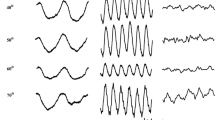Abstract
Effects of target size, eccentricity and background luminance were determined for static and acuity profile perimetry in the central 30° radius of the visual field. Reductions in target size produced decreases in sensitivity for both functions, with acuity profiles (resolution sensitivity) being more affected than static profiles (detection sensitivity). At photopic background luminances, detection sensitivity was greatest at the fovea and progressively declined with increasing eccentricity; lower background luminances produced greater detection sensitivity for the near periphery than for the fovea. Resolution sensitivity for small targets (20/80 or less) exhibited a rapid decline with increasing eccentricity that was relatively independent of background luminance, whereas large targets (20/125 or greater) revealed findings similar to the detection sensitivity results. The relative contributions of rods and cones to threshold visual responses thus appear to depend on the type of visual task, target size, eccentricity, background luminance and thek interactions. These data provide a comparison basis for future evaluations of patients with photoreceptor dysfunction.
Similar content being viewed by others
References
Aulhorn, E. & Harms, H. Visual Perimetry. In: Handbook of Sensory Physiology, Vol. VII/4, ed. by Jameson, D. & Hurvich, L. Springer, Berlin, 1972.
Bair, H.L. Some fundamental physiologic principles in study of the visual field. Arch. Ophthal. 24: 10–20 (1940).
Brown, J.L., Graham, C.H., Leibowitz, H.W. & Ranken, H.B. Luminance thresholds for the resolution of visual detail during dark adaptation. J. Opt. Soc. Amer. 43: 197–202 (1953).
Cornsweet, T.N. The staircase method in psychophysics. Amer. J. Psychol. 75: 485–491 (1962).
Enoch, J.M., Lazarus, J. & Johnson, C.A. Human psychophysical analysis of receptive field-like properties: I. A new transient-like visual response using a moving windmill (Werblin-type) target. Sensory Processes 1: 14–32 (1976).
Fankhauser, F. & Schmidt, T. Die optimalen Bedingungen für die Untersuchung der räumlichen Summation mit stehender Reizmarke nach der Methode der quantitativen Lichtsinnperimetrie. Ophthalmologica 139: 409–423 (1960).
Greve, E.L. Single and Multiple Stimulus Static Perimetry in Glaucoma: The Two Phases of Perimetry. Junk, The Hague, 1973.
Harvey, L.O. & Pöppel, E. Contrast sensitivity of the human retina. Amer. J. Optom. 49: 748–753 (1972).
Johnson, C.A. & Keltner, J.L. Static and acuity profile perimetry in optic neuritis. Docum. Ophthal. Proc. Ser. (IV International Visual Field Symposium), (in press 1980).
Johnson, C.A., Keltner, J.L. & Balestrery, F.G. Effects of target size and eccentricity on visual detection and resolution. Vis. Res. 18: 1217–1222 (1978).
Johnson, C.A., Keltner, J.L. & Balestrery, F.G. Acuity profile perimetry: Description of technique and preliminary clinical trials. Arch. Ophthal. 97: 684–689 (1979).
Keltner, J.L., Johnson, C.A. & Cowley, I.J. Acuity profile perimetry in a unique case of bilateral central serous retinopathy. Ann. Ophthal. 12: 727–731 (1980).
Kerr, J.L. Visual resolution in the periphery. Percept. Psychophys. 9: 375–378 (1971).
Long, G.M. The unspecified role of cones and rods in grating detection: A theoretical note. J. Opt. Soc. Amer. 68: 1009–1012 (1978).
Low, F.N. Peripheral visual acuity. Arch. Ophthal. 45: 80–99 (1951).
Mandelbaum, J. & Sloan, L.L. Peripheral visual acuity. Amer. J. Ophthal. 30: 581–588 (1947).
Millodot, M., Johnson, C.A., Lamont, A. & Leibowitz, H.W. Effect of dioptrics on peripheral visual acuity. Vis. Res. 15: 1357–1362 (1975).
Pöppel, E. & Harvey, L.O. Light-difference threshold and subjective brightness in the periphery of the visual field. Psychol. Forsch. 36: 145–161 (1973).
Randall, H.G., Brown, D.J. & Sloan, L.L. Peripheral visual acuity. Arch. Ophthal. 75: 500–504 (1966).
Sloan, L.L. Area and luminance of test object as variables in examination of the visual field by projection perimetry. Vis. Res. 1: 121–138 (1961).
Sloan, L.L. The photopic acuity-luminance function with special reference to parafoveal vision. Vis. Res. 8: 801–911 (1968).
Sloan, L.L. The Tübinger perimeter of Harms and Aulhorn. Arch. Ophthal. 86: 612–622 (1971).
Weymouth, F.W. Visual sensory units and the minimal angle of resolution. Amer. J. Ophthal. 46: 102–113 (1958).
Author information
Authors and Affiliations
Rights and permissions
About this article
Cite this article
Johnson, C.A., Keltner, J.L. & Balestrery, F.G. Static and acuity profile perimetry at various adaptation levels. Doc Ophthalmol 50, 371–388 (1981). https://doi.org/10.1007/BF00158022
Issue Date:
DOI: https://doi.org/10.1007/BF00158022




